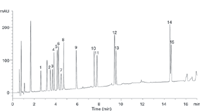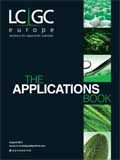Improved Analysis of Preservatives in Cosmetics Using a Unique Core-Shell Phase
The Application Notebook
Phenomenex Application Note
Introduction
Preservatives prevent product deterioration and deter any possible health risks microorganisms may cause to the consumer; however, a disadvantage of using such agents is that they may cause adverse effects, such as allergic responses and irritation. There is a need today for a fast, efficient and selective HPLC method to screen for such common and dangerous preservatives.

Results
Cosmetic products can only use a limited number of preservatives selected from a positive list, Annex VI of the Cosmetics Directive, which also defines preservative maximum permitted levels and areas of use. The esters of parahydroxybenzoic acid (paraben), methyl paraben, ethyl paraben, propyl paraben and butyl paraben are standard substances among the preservatives list.

Figure 1: High performance separation of 15 preservatives on Kinetex 2.6 µm XB-C18.
Figure 1 illustrates the ability of the Kinetex XB-C18, 2.6 µm core-shell column to rapidly screen and separate all 15 compounds. In this separation, the Kinetex XB-C18 column offered a peak capacity of 445, which was higher than any other column evaluated in the experiment. Peak capacity is the best measure of performance for a gradient separation and high peak capacity values indicate increased analyte resolution over a given analysis time.
The core-shell particle morphology allows for faster mass transfer of analytes into and out of the stationary phase as compared to fully-porous silica particles. In addition, the very narrow particle size distribution inherent in core-shell silica particles, as compared to fully-porous particles, results in less band broadening.
Kinetex 2.6 µm XB-C18 was able to separate the chlorinated compounds triclosan and triclocarban, which can be challenging. This is likely due to the unique XB-C18 selectivity. The Kinetex XB-C18 chemistry contains protective di-isobutyl side chains that shield the silica surface. In addition, the surface is endcapped with trimethylsilane.
Analysis of preservatives in cosmetics was accomplished at an operating pressure under 400 bar and may therefore be used on conventional HPLC systems without the need for specialized ultra-high pressure equipment.
Conclusion
An ultra-high performance liquid chromatography method has been developed for the simultaneous determination of 15 preservatives in cosmetics. The method was developed to achieve the best balance of analysis time and separation.
The Kinetex XB-C18, 2.6 µm column provided high peak capacity and the unique selectivity of the XB-C18 was wellsuited for the application.
Phenomenex Inc.
411 Madrid Ave., Torrance, California 90501, USA
tel: +1 310 212 0555 fax: +1 310 212 7768
Website: www.phenomenex.com


Regulatory Deadlines and Supply Chain Challenges Take Center Stage in Nitrosamine Discussion
April 10th 2025During an LCGC International peer exchange, Aloka Srinivasan, Mayank Bhanti, and Amber Burch discussed the regulatory deadlines and supply chain challenges that come with nitrosamine analysis.



















